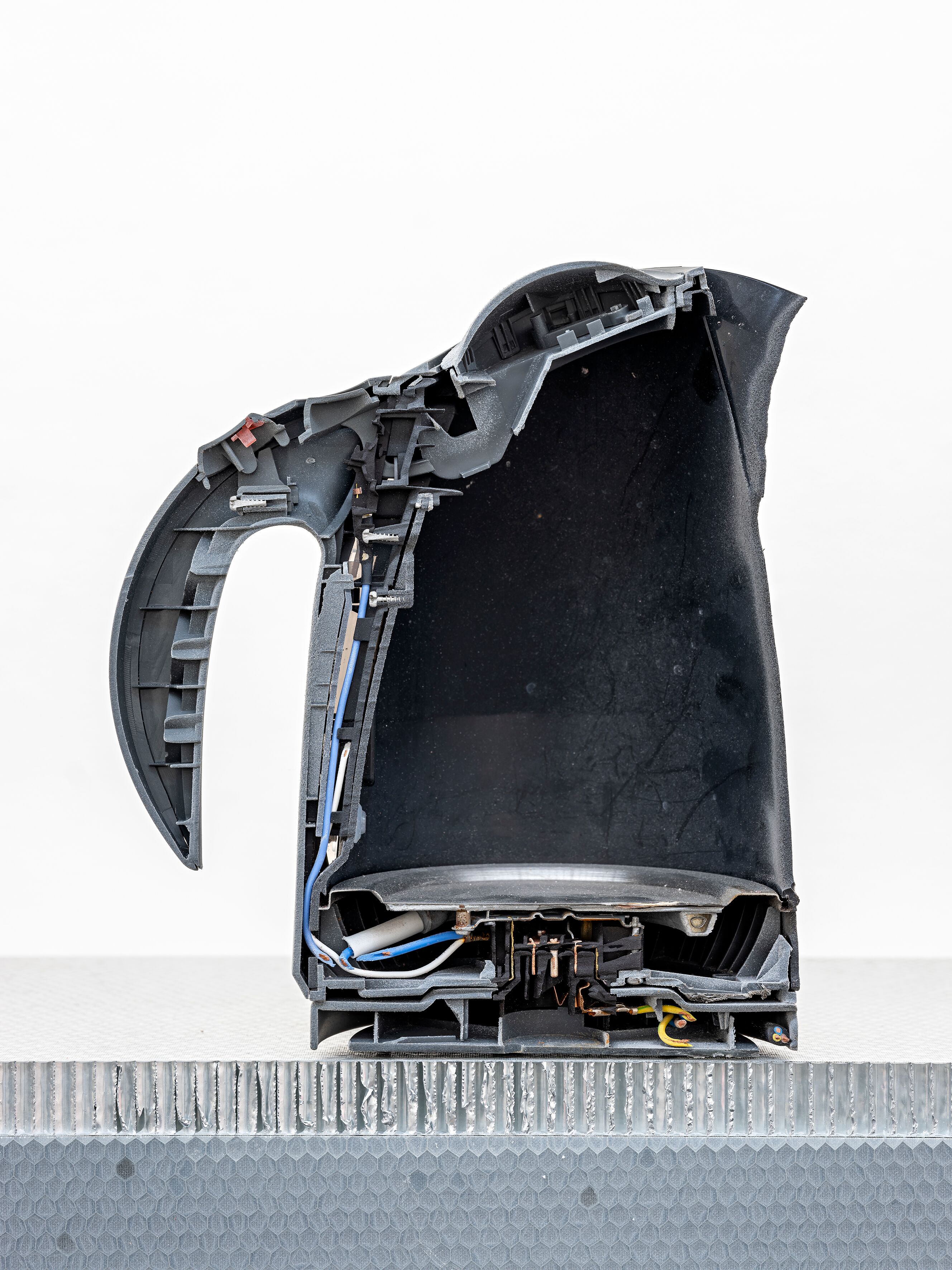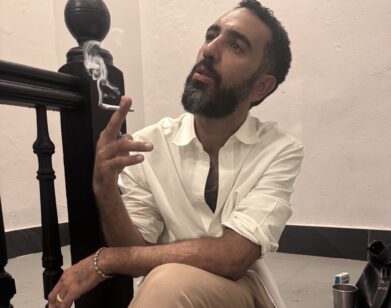What Is An Idea? Yngve Holen Has No Idea

Photo by Richard Dowker.
In July of last year, the 37-year-old Norwegian artist Yngve Holen walked into the Max Planck Institute for Brain Research in Frankfurt. Donning a medical smock and mask, he toured the laboratory and came upon a team of surgeons performing optogenetic research on a lizard. Over the next few minutes, surgeons removed the lizard’s dorsal plate to inject its brain with a genome-laced algae mixed with blue dye. Surrounded by state-of-the-art medical equipment and monitors tracking the animal’s brain activity in real time, the doctors then replaced the dorsal plate before sealing any holes with silicon and dental cement.
This trip to the Max Planck institute took place in the process of creating the fourth edition of Holen’s research magazine ETOPS, entitled Headache. Trips like these are par for the course for the artist whose work over the last decade has highlighted technologies redefining of the contemporary body. In past issues of his magazine, Holen has interviewed plastic surgeons and porn stars, scanned a Boeing airplane with a laser, and gone to the Amazon to interview boutique chefs, in each instance casting himself in the lead role as curious European tourist.
Headache has been released on the occasion of Holen’s exhibition Corpus Quality, which opened last night at Stuart Shave/Modern Art in London. The show is focused around a series of sandblasted animal-warrior action figures that are based on a discontinued LEGO series called “Legends of Chima.” There’s a falcon, a panther, and a saber-toothed tiger named Sir Fangar. All of them are scaled up versions of their original plastic toy form, and together they play on the artificial powers and simultaneous weaknesses displayed in the of lab animals that Holen saw while doing research for Headache.
———
PATRICK MCGRAW: What type of lizard was it?
YNGVE HOLEN: I think it was a dragon? A bearded dragon?
MCGRAW: Why LEGO?
HOLEN: They’re a series of LEGO characters called Chima that got introduced in 2013 and then discontinued in 2015. It’s kind of like this short lived world that existed in the LEGO catalogue. They’re different animal tribes. There’s a fire tribe and an ice tribe, and they fight each other for this sparse resource called CHI. They all have this crest on their armor, and when they insert CHI into it they get high and go wild and race each other.
———
The magazine sets the mood for Holen’s exhibition through a series of long-form interviews with scientists on subjects ranging from Transcranial Magnetic Stimulation (TMS), the video game Fortnite, Nazi brain thievery, and many forms of neuropsychedelia. However, its main focus is the aforementioned optogenetics, a new field of research that aims to control individual neurons by injecting them with a light-sensitive algae virus. Aside from its medical implications, the hype around optogenetics is that it’s a big step toward being able to control the functions of our own brain. On biohacking forums, posters with aliases like “DirectorX” muse about being the first human to have infrared vision or to use optogenetics to hack their sensory systems and hallucinate at will by turning their neurons on and off like a light switch.
But as one reads through Holen’s interviews in Headache, it becomes clear that we are still in the dark ages of understanding how the brain actually functions. As one scientist put it: “You would need every computer on earth and still be one billionth away from being somewhere in the ballpark of even thinking about how the brain works. We have only a fraction of any understanding of the brain. Under 10 percent.” Even the processes we use to study the brain themselves seem medieval at times. Pumping brain cells with electricity, injecting them with viruses, or dragging magnets across a person’s skull are just some of the crude experiments documented in Headache.
———
MCGRAW: TMS is like when they drag a magnet across your head?
HOLEN: You place a magnet on someone’s head, then you charge it and stimulate it with electricity.
MCGRAW: You had TMS done on yourself?
HOLEN: Yeah. It’s said that if you stimulate the visual cortex correctly, you’re able to see tribal patterns and ayahuasca type stuff. It didn’t work so well on me. I just got a headache afterwards.
———
Methods of hacking the brain are also found in less heady scenarios. In big cities across the globe, young professionals pack their brains with a cocktail of substances they think will make them more productive and unique: coffee, CBD, adderall, modafinil, klonopin, as well as drugs like ketamine or cocaine on the weekends. In an economy of hyper-personalization, our brains have become the bespoke creations of our own consumer habits. Holen’s falcon figurines on display at Stuart Shave begin to coincide with an image of the contemporary brain. Speaking to itself in a language we can’t comprehend, the brain begins to resemble an inscrutable color-coated dashboard of buttons.
———
HOLEN: While I was doing these interviews for Headache the past two years, I had these LEGO pieces around and started collecting them. It’s like, when you go to a lab and you start seeing lizards with chips in their heads, or you see all the research done on mice, you start thinking about these lab animals. It goes back to what kind of concepts you create for yourself to understand what is going on in the world. Or, what kind of ideas do you come up with to teach children about the world? What kind of languages are built to teach people about this stuff?
———
The brain and its reconfiguration have always been central themes in Holen’s work. For his earlier series Parasagittal Brain, he cut mass-produced household kitchen items in half with a water saw. Tea Kettles, a water cooler, a “smart fridge.” The lobotomies Holen performed on these objects follow a bipolar arc: on the one hand, cutting these things open could be read as an attempt to study the unseen inner-workings of technology, and on the other, it’s pure hijinx. As Holen explains, neuroscience itself is sometimes a sick joke: “Using your brain to think about the brain is like using water to cut a kettle.”

Parasagittal Brain. Photo: Vegard Kleven. Courtesy the artist.
Holen’s fetish for cutting things reached its apex with “VERTICALSEAT,” a solo show at Kunsthalle Basel in 2016. In the barren whiteness of a 19th-century gallery space, Holen mounted CAKE, a black Porsche Panamera cut by an industrial saw into four pieces.
The show plays on the notion of “Future Shock,” a term coined by Heidi and Alvin Toffler in 1970 that describes the state of shock and terror a person enters when they witness too much change in too short a period of time. Something like an airplane or even a Bic lighter could send somebody into a state of panic due to the accelerated and disposable future these objects represent. But after decades of anxiety caused by the future, not only do objects no longer shock us, but we want to be shocked by them. Seeing objects that disturb us has become a form of mental creative destruction and we purposefully go to see a Porsche cut into four pieces, no longer knowing if it’s the Porsche we desire, or the Porsche’s destruction.

Installation view, VERTICALSEAT. Kunsthalle Basel. Photo: Robert Glowacki. Courtesy the artist.
Downstream from the lizard-filled laboratories, neuroscientists have begun heading for Silicon Valley, believing that data is as powerful as pharmacology and apps are the new drugs. As a scientist in Headache puts it: “Going forward we should count on apps rather than psychopharmacological drugs.” The specificity with which an app can target and alter a person’s brain shows how when everything is boiled down to neural data, there is little difference between an acid trip, playing Fortnite, being addicted to social media, or optogenetics. Pure information itself is mystical.
———
HOLEN: Corpus Quality started when I put a LEGO in a CT scanner, took that info and scaled it by about 70 percent. It’s still a toy, but it starts to become a little bit menacing. Like the weapons and their swords and shields become actual weapons.
MCGRAW: They look like Bronze Age warriors you would see at the Met.
HOLEN: They’re cast in bronze, so they look a little bit like dead ancient warriors. With the actual LEGOs you can move them around, but we froze these figures so they can’t move. I like the way it makes the heads hang a little bit. On the wall they look like a cheesy artifact.
MCGRAW: In Headache, you question what the difference between a mystical experience and a psychotic episode is.
HOLEN: Maybe we’re having psychotic episodes all the time, no?
MCGRAW: Have you ever had a psychotic episode?
HOLEN: I don’t think so.
———
Corpus Quality is the continuation of a body of work that is constantly reimagining related concepts and playing them off each other. It’s an ouroboric form of creation that Yngve himself acknowledges when speaking about the show: “In a way, what I’m doing now is a reworking of the earlier works.” On the back cover of Headache, there’s a picture of one of Holen’s dissected kettles from 2011 with various questions posed underneath it. What is an idea? What is a concept? How are these things formed in the brain? The answer is written at the very bottom: “We have no idea.”






